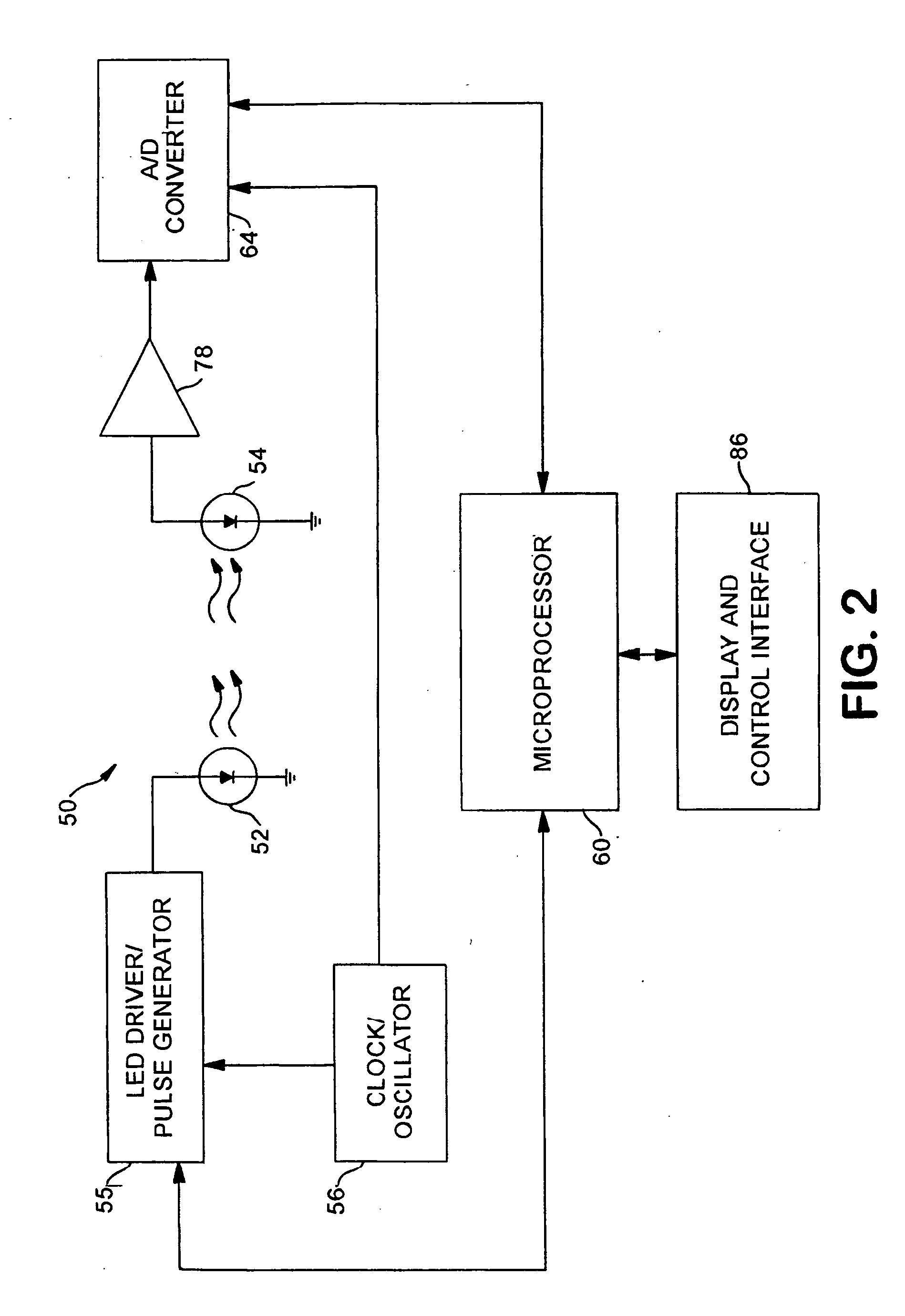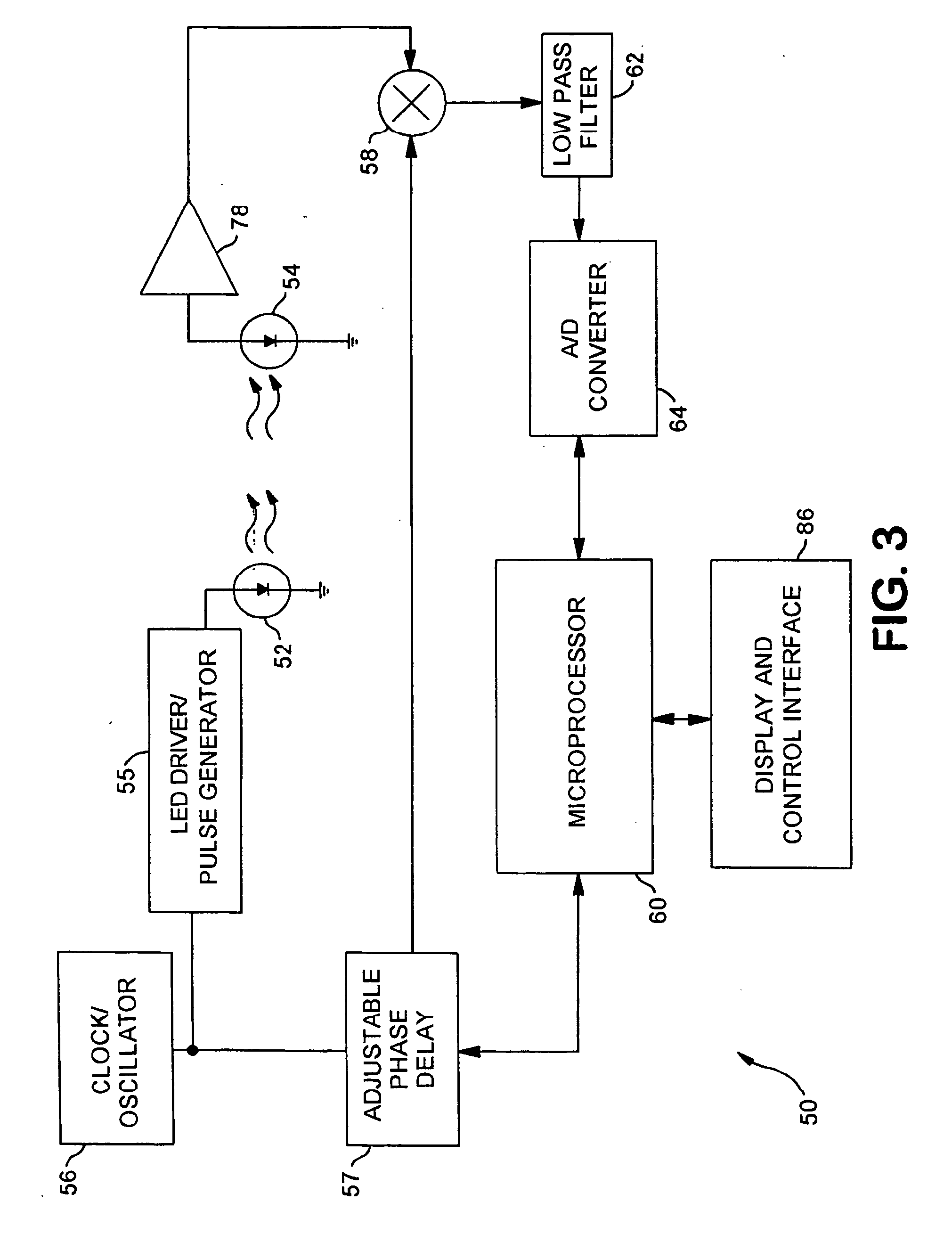Membrane-based lateral flow assay devices that utilize phosphorescent detection
a membrane-based assay and detection method technology, applied in biomass after-treatment, instruments, enzymology, etc., can solve the problems of limiting the use of phosphorescent detection in most practical assay applications, many of the proposed techniques are simply ill equipped for lateral flow,
- Summary
- Abstract
- Description
- Claims
- Application Information
AI Technical Summary
Problems solved by technology
Method used
Image
Examples
example 1
[0063] The ability to encapsulate platinum(II)tetra-meso-fluorophenylporphine (Pt(II)-MTPFP) in carboxylated latex particles was demonstrated. Initially, 8 milligrams of a carboxylated latex particle suspension (0.3-micrometer particle size, available from Bangs Laboratories, Inc) was washed twice with ethanol and then suspended in 100 microliters of ethanol. 100 micrograms of Pt(II)MTPFP in 55 microliters of methylene chloride and 45 microliters of ethanol was added to the particle suspension. The mixture was gently shaken for 20 minutes. Then, 100 microliters of water was added. The mixture was then shaken overnight. Approximately 50 vol. % of the solvent was then removed by air stream. 1 milliliter of ethanol was added and centrifuged, after which the supernatant was discarded. The particles were further washed twice with ethanol and then twice with water. The washed particles were suspended by bath sonication in 1.5 milliliter of water for storage. The particles exhibited very s...
example 2
[0064] The encapsulation of platinum(II)tetra-meso-fluorophenylporphine in polyacrylonitrile particles was demonstrated. 118.5 milligrams of polyacrylonitrile and 1.19 milligrams of platinum(II)tetra-meso-fluorophenylporphine were dissolved in 25 milliliters of DMF. 125 milliliters of water was added to the mixture under vigorous stirring. Thereafter, 1 milliliter of a saturated sodium chloride aqueous solution was added to precipitate the dispersed particles. The mixture was centrifuged for 15 minutes and then washed twice with a sodium chloride solution (5 wt. %) and three times with 50 milliliters of water. The residue was then heated for 15 minutes at 70° C. and centrifuged in a phosphate buffer. This procedure is substantially identical to that described in Bioconjugated Chemistry, Kurner, 12, 883-89 (2001), with the exception that the ruthenium complexes were replaced with platinum(II)tetra-meso-fluorophenylporphine.
[0065] The resulting encapsulated particles exhibited very s...
example 3
[0066] The ability to conjugate an antibody to phosphorescent particles was demonstrated. The particles were carboxylated latex phosphorescent particles having a particle size of 0.20 micrometers, 0.5% solids, and exhibiting phosphorescence at an emission wavelength of 650 nanometers when excited at a wavelength of 390 nanometers. The particles were obtained from Molecular Probes, Inc. under the name “FluoSpheres.”
[0067] Initially, 500 microliters of the particles were washed once with 1 milliliter of a carbonate buffer and twice with 2-[N-morpholino]ethanesulfonic acid (MES) buffer (pH: 6.1, 20 millimolar) using a centrifuge. The washed particles were re-suspended in 250 microliters of MES. Thereafter, 3 milligrams of carbodiimide (Polysciences, Inc.) was dissolved in 250 microliters of MES and added to the suspended particles. The mixture was allowed to react at room temperature for 30 minutes on a shaker. The activated particles were then washed twice with a borate buffer (Polysc...
PUM
| Property | Measurement | Unit |
|---|---|---|
| size | aaaaa | aaaaa |
| size | aaaaa | aaaaa |
| size | aaaaa | aaaaa |
Abstract
Description
Claims
Application Information
 Login to View More
Login to View More - R&D
- Intellectual Property
- Life Sciences
- Materials
- Tech Scout
- Unparalleled Data Quality
- Higher Quality Content
- 60% Fewer Hallucinations
Browse by: Latest US Patents, China's latest patents, Technical Efficacy Thesaurus, Application Domain, Technology Topic, Popular Technical Reports.
© 2025 PatSnap. All rights reserved.Legal|Privacy policy|Modern Slavery Act Transparency Statement|Sitemap|About US| Contact US: help@patsnap.com



